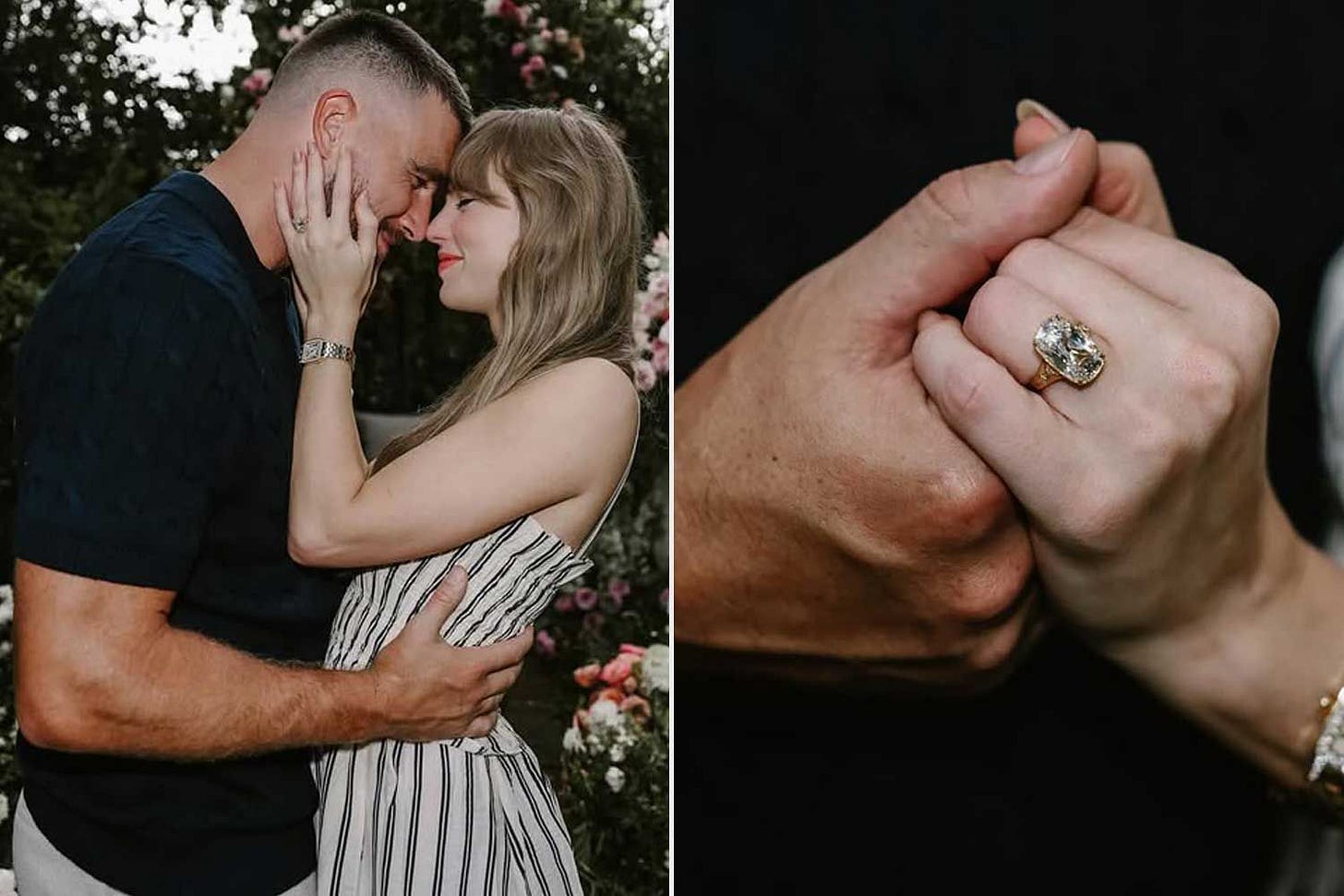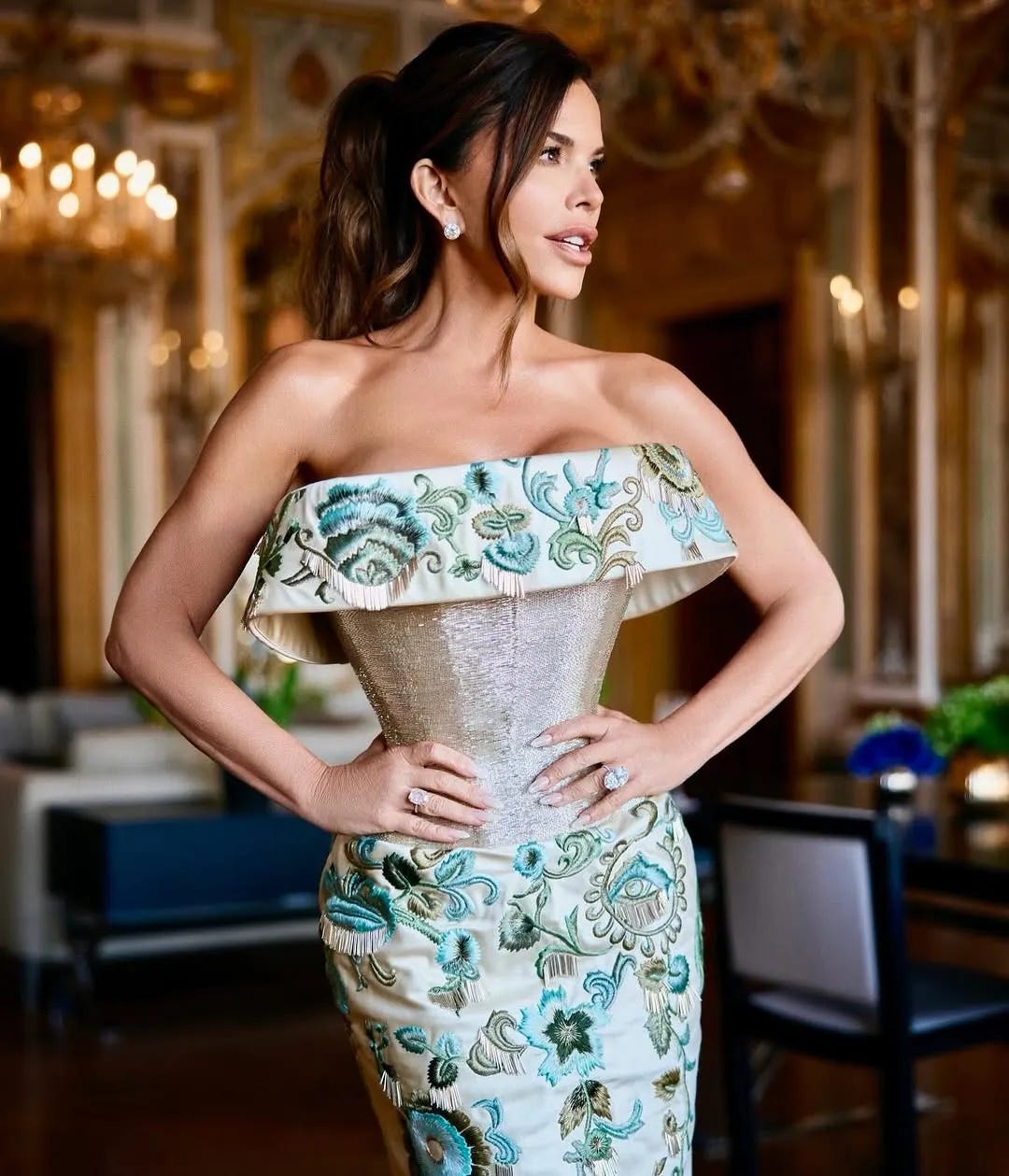Goodbye Thin. Hello Sculpt.
The next frontier in women's body standards.
Welcome to Pop Syllabus 101. It’s been a delicious few months for us students of pop culture.
Taylor Swift and Travis Kelce got engaged, showing what happens when love, a billion dollars and a dash of CTE wins. Kelce, the archetypal suburban man who flirts with Black culture/women in his 20s but opts for endogamy when it counts, did a splendid job with the ring. I’m rooting for them; I bet Laura Wasser is not.
Sydney Sweeney, her MAGA milkies and a gene jean ad ignited a debate about eugenics. It seems Sweeney’s made the same calculation as the influencer tradwives on your FYP. They’ve figured resistance is hard; maybe even futile. Might as well capitulate, comply, and most importantly get money while doing it. And who am I to judge? I’m here pimping myself out on Substack!
Speaking of money and influencer “tradwives”, my favorite birascal OluwaMarkle dropped season 2 of her cooking show and started selling literal wine to her wine mom fanbase. We are not worthy of her cunning!
As much as I love all those beautifully messy subjects none of them felt right for my first pop syllabus essay. If you’ve followed me online for any amount of time, you’ll know cultural predictions are kind of my thing. My former boss often called me “witchy”. When I told my mother that, she rebuked it and said I’m “anointed”. Whatever the case, I thought it’d be fitting to kick off with a prediction about what’s on the horizon for body beauty standards. Cocky, I know! But I trust my intuition; she will not lead my astray.
When you regularly 3D print human beings (I’ve given birth three times in five years), you learn a lot about how society feels about women’s bodies. Between the unsolicited advice, strangers touching your belly, and the medical industrial complex determining your birth preferences; you find out that your body doesn’t really belong to you.
After your delivery, the concern and care vanishes, and you‘ll re-enter a society that despises bodies that reveal that they’ve given birth. Society doesn’t like women’s bodies when they show signs of strife, difference, or disability. In this patriarchal hellscape, women's bodies exist solely to uphold society’s aspirations. These aspirations are unstable and constantly changing, though. As a result, the goal post of what the ideal women’s body even is will always move.
Right now, Ozempic and other GLP-1s are rapidly democratizing thinness, making it attainable to whomever can afford it. As a result, the value of thinness as a status symbol is diminishing, and I believe we’re about to enter a significant shift. Be prepared for The Sculpt*
*When I say prepare, I don’t mean get ready to embrace the next body trend and if you do abeg don’t blame me! That is not the point of this essay. Remember at Pop Syllabus we strive towards a world where all women have the freedom to be ugly in peace!
What is The Sculpt?
Heavily influenced by the key tenets of body building culture, the sculpted body is extremely low in body fat, with defined lean muscles that can only be achieved through exercise. Although visible abs, and a chiseled back are a must, being read as hyper feminine is also a key priority. In what might appear to be a visual contradiction, the sculpted body has features that typically require sufficient body fat to exist: a youthful perky bust, buttocks that appear naturally lifted, etc. The balance between muscle and fat in the right places, and appearing small and strong, is one that must be constantly recalibrated.
The Sculpt will be incredibly difficult to achieve naturally and may even require surgical interventions, whether it’s subtle arm liposuction, or even a costectomy (rib removal/remodeling) to create a tiny waist. The Sculpt is global, ostensibly racially neutral but looks towards the west in its gaze and aspirations. It’s also been shaped by the trends and beauty ideals pioneered by Black and Brown women in the late aughts (waist training, the BBL look, etc.), that were later appropriated by others.
The Sculpt will require intense discipline, an immense amount of money and time. Only the elite or those with access will be able to attain and maintain it. In many ways it can only be assembled and supported by a team. The team members may vary but it might include personal trainers, nutritionists, medical doctors (both holistic, and mainstream), wellness coaches etc. The public will see The Sculpt and strive towards it, unaware of how much goes into making it possible.
A crucial feature of The Sculpt body and lifestyle is the way it will merge wellness culture with technology, (artificial intelligence, wearable devices like glucose biosensors, in-home hyperbaric oxygen chambers etc.) to bio-hack and self-optimize women’s bodies in ways we’ve never seen before.
And I know what you’re thinking. The Sculpt seems a little extreme. Rib removal? Oxygen chambers? Women trying to be tiny and muscular? It reads a bit like a dystopian sci-fi body horror movie (should I be writing it on spec?!). But in many ways, I think it was inevitable we’d land here.
The advocacy of fat-inclusive activists, and body positivity influencers throughout the 2010s meant that there was a time where it felt like the toxicity of early aughts dieting culture and naked fatphobia might one day be behind us. It certainly felt that way for me in 2020 when I gave birth to my first cocofelon. The timeline was anti-snapback culture. Curves were to be accepted; stretch marks were strength marks.
By the time my second child was born in the summer of 2023, body positivity and all the other cultural hashtag awakenings #TransLivesMatter, #BlackLivesMatter, #MeToo etc, were being pushed back to the margins. Thin was firmly back in, so much so the biggest movie of the summer was Barbie. The Greta Gerwig Margot Robbie combo meant the movie was framed as empowering. Going to see it was good for women! And cinema! We didn’t dwell on the deeply complicated and perhaps harmful beauty ideals Barbie represented, or how weight bias was still so ingrained in our culture, a study by Professor Jennifer Harriger showed young girls were less likely to pick the curvy Barbie to play with.
As depressing as it may feel, Serena Williams’ GLP-1 endorsement isn’t that shocking. A recent RAND poll showed 12 percent of Americans have used a GLP-1 for weight loss. That number jumps to 20 percent when you look at women between 50 and 64. Serena knows, much like countless aging women, that in order to fight the inevitably of their invisibility, your body must shrink to be seen.
It isn’t just Serena or aging women. So many of the plus size influencers, celebrities and fat positive activists who challenged our perceptions about what a beautiful body could be, are also visibly smaller. And the abuse they received about being fat has morphed into complaints about how they look with less weight. We have developed an entire lexicon to judge and demonize how women look because of GLP-1s. There’s Ozempic face, Ozempic butt, Ozempic vulva (so much to unpack here, my God!) and some plastic surgeons even offer a post Ozempic makeover.
All in all, it’s just shorthand for your (purchased, fake) skinny, is not like my (earned, natural) skinny. Ultimately it’s emblematic of the inherent tension that the rise of GLP’1s creates. Where the interests of Big Pharma (who want as many customers as possible) conflict with other capitalist forces that still need women (particularly wealthy White women), to use thin bodies to communicate status and distinguish themselves from everyone else.
Sculpt Signs
I was in a Pilates class last summer, and a woman on the reformer beside me performed a maneuver so impressive, I gasped. Noticing my amazement, the instructor said, “It’s her second class of the day”. It was only 10 am. I vividly remember thinking, “What kind of money are people making that they can afford to do this class twice in a morning?! Do I need to start stealing?!?”. I later discovered the young woman was in town from Mexico City where she owned a Pilates studio. I didn’t think much of it… but then it kept happening.
In a barre class a few weeks later I met a woman from Seoul on her second class of the day, about to head across town for her third. I met another woman visiting from Sao Paolo. Then of course there were the native Angelenos (and transplants), who I discovered were all doing multiple workout classes a day, most days of the week.
Even though these women were different ethnicities and from different parts of the world, they all had the same body type. Petite, ripped, appropriately busty, and behinds that had the country club BBL look (and yes that’s an actual thing). Basically the type of body you couldn’t get just from Ozempic.
The Kardashians are often accused of being talentless, however they’re talented enough to know being a pioneer is a losing game, and if you waste time trying to create the wave, you’ll miss the opportunity to hop onto a wave just before it rises and hits peak profitability. As a result, they’ve mastered an often-underrated skill – being masters of timing.
When Kim Kardashian showed up to the 2022 Met Gala blonde, thin and with a White man as a date, it was a cultural inflection point. A signal that body positivity and ethnic ambiguity were out and something else was coming. And because Kris Jenner’s womb/mind is so powerful another Kardashian is a harbinger of what’s to come. Who is it you ask? (drumroll please) The stone the builders rejected! My self-flagellating fave! Khloe Kardashian.
While doomscrolling TikTok late one night, I came across a video of Khloe accepting an award in Germany. I couldn’t stop watching it because I knew something was afoot. (Read the comments, the vast majority are complimenting her body. Particularly the definition in her back and arms). Khloe isn’t the only celeb sporting this look.
We see it displayed perfectly by Lauren Sanchez Bezos at her pre-wedding celebration in Venice. Showing off her athletic arms and tiny waist in a corseted Schiaparelli couture dress. Recent pictures of Lori Harvey summering in Europe are in the same vein.
As it turns out The Sculpt; the body of the future, is kind of already here. If you live in a cosmopolitan city, you will soon begin to see it everywhere, and no matter where you live; you won’t be able to escape its influence.
Postscript
Before I go, I want to say that I think we’re living in a deeply triggering time for women in recovery from eating disorders, women who are on the fence about GLP-1s sick of getting hints to try it, women whose concern about their bodies have nothing to do with the aesthetic but more about trying to survive a chronic illness, millennial women raising young girls despairing at the resurgence of diet culture….It’s all kind of bleak?
If I were less cynical, this would be the part of the class where I’d say love your body the way it is. However, my own challenges with infertility and recurrent pregnancy loss have deeply humbled and dare I say scarred me. I have come to believe a body is far too fickle a thing to love. This is a topic I’ll return to because it’s so rich, layered and important.In the interim argue/agree/disagree/share with me in the comments. I’d love to talk more about it with you all.
I do believe at some point we need to find ways to disconnect from this loop that keeps women yearning, loathing and spending their way into different bodies. Maybe by the time this course is done, we’ll be free to be ugly in peace.
Till next time.
CMM x










The joy I felt when I received the notification that this had been published! I thoroughly enjoyed this essay and appreciate that you didn’t conclude with just telling us to love our bodies because there are so many factors that influence our relationships with ourselves.
Maybe it’s because I’m getting older and life really did come at me fast but I’ve reached the point where I simply sympathise with women now for excessively exercising and/or taking Glp-1 whereas before I’d judge them.
When Serena announced that she had been taking Zepbound I felt like one of only a few who could see why she would do it. It’s messy considering it’s a company her husband has invested in but her body has been talked about and mocked for years despite it being what made her one of the greatest athlete’s alive and now she’s no longer playing tennis I can see why she’d want to experience life on the slimmer side.
This is such a good article. I’ve definitely thought about this: what happens when everyone can ‘easily’ be thin? They (media, other women, capitalism) will always have women chasing some difficult to attain ideal. It’s boring and exhausting now. We need to revolt!!